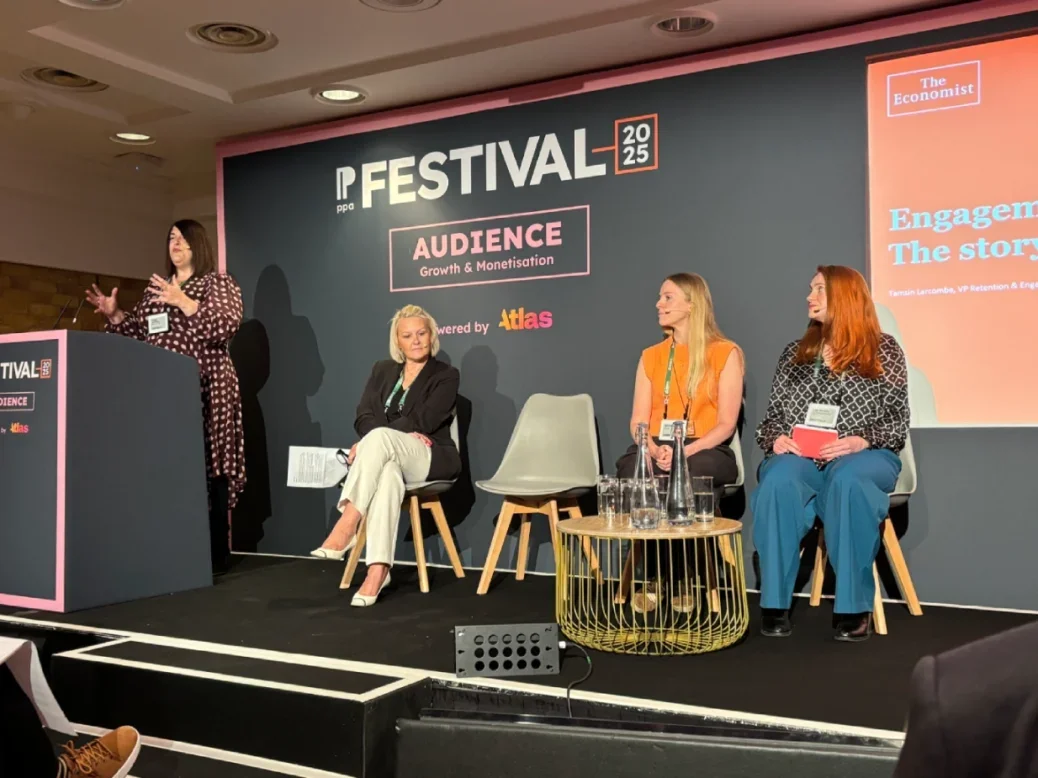
The Economist has rolled out a new content engagement model designed to build habits and improve retention among its 1.2 million global subscriber base.
Engaged customers are worth around a fifth more than the “average” customer, according to 2023 data from Gallup. “That’s a huge opportunity that’s going to spike the attention of any CEO or CFO,” said Tamsin Larcombe, VP of retention and engagement at The Economist.
“We’re already seeing a positive change across the business… engagement is now a KPI that’s discussed daily across our editorial and commercial teams.”
Larcombe explained the rationale for building a new data-driven model at the PPA Festival in London earlier this month. “Our previous model was created pre-Covid, and wasn’t easily actionable. It measured each interaction equally – so reading a newsletter was considered to be the same value as reading a single article.
“Now we have more formats. We have narrated articles, podcasts, subscriber-only webinars, as well as a growing newsletter portfolio.”
Insights from The Economist’s data science team backed up the working hypothesis that “not all content engagement is equal”, with Larcombe highlighting that “attending a webinar or listening to a podcast has a different [retention] value than reading an article.”
Since last autumn, the publisher has been assigning weightings to each type of digital engagement from a subscriber, allowing them to “build a calculator to understand how much increased engagement is worth to business.” Some types of engagement can be worth 25 or even 100 times more than others, said Larcombe.
She wouldn’t be drawn on the precise details of the “commercially sensitive” weighting formula, but suggested that more intimate content like podcasts and webinars would likely receive higher weightings than reading a text article. However, she also pointed out that there are far more “regular opportunities” for the latter, and that frequency is also an important consideration in the modelling.
Economist app gets more investment
Better understanding relative engagement has highlighted how important it is for subscribers to use The Economist’s flagship app.
“Being able to demonstrate the value of the app helped us show we needed to invest in replatforming and making the app better,” said Larcombe. “It’s a big investment but it’s really key.”
Alongside the print edition, The Economist app has become increasingly central to the subscriber experience, moving from originally being a print replica app to one that is continuously updated, including daily stories, the weekly edition, podcasts, videos and article read-outs.
Most Economist podcasts, for example, are held back for paying subscribers, whether they listen to them in the app or by linking their subscription to a third-party player.
Core engagement ‘can’t necessarily be measured in clicks’
Improved modelling also means The Economist has been able to build a clear audience segmentation and testing strategy, which Larcombe said “means we can be really granular on the actions we want users to take next”.
While building sophisticated engagement models like this is becoming vital for subscription publishers, she also stressed their limitations.
“Even this new model looks only at digital engagement, which is just one side of it. Core engagement is actually more of a feeling – it’s your personal emotional connection or relationship with the brand, and you can’t necessarily measure that in digital clicks.
“Some of our [print and digital] bundle subscribers may choose to only interact with the print newspaper. So if you were to only look at the engagement data, they would look like a high-risk cohort because they’re not engaging digitally. But actually they’re probably our most loyal customers.”
To supplement the modelling, The Economist commissioned a major reader survey to delve deeper into subscribers’ own usage and perceptions of the brand, with Larcombe highlighting some surprising results.
“One of the fascinating insights was how a lot of subscribers thought that they used or engaged with The Economist far more than we thought they did, from our data. But this really positively influences their perception of value for money perception, and therefore reduces their likelihood to churn.
“So just because, from a modelling perspective, we might not think that they’re that engaged, they’re engaged enough for them. It’s been important to overlay this analysis onto the digital data, otherwise we’d have lost that nuance.”
Email pged@pressgazette.co.uk to point out mistakes, provide story tips or send in a letter for publication on our "Letters Page" blog
